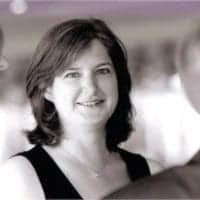The next installment in the blog series, Meet the Women’s World Banking team: an interview with one of our newest team members, Kate Glynn-Broderick.

What interests you most about the work you do?
I’ll give you an example. Prior to coming to Women’s World Banking, I was deputy director of the research group for the City of New York Office of Financial Empowerment. We conducted research on the unbanked population in the city, for example, one study focused on immigrant financial services. We looked at three recent immigrant groups – from Mexico, Ecuador, and China. We found that debt levels were extremely low, and that all three groups saved money [particularly for education], but not necessarily in formal institutions.
So, one reason I love research so much is that we find out interesting things: We learned that the Mexican population was the most unbanked of the three groups. We went to the Mexican consulate and conducted a needs assessment survey. We found that people were really interested in saving for taxes. Even if they were undocumented they wanted to file taxes, with the hope of becoming documented.
The result was that we created a program in the consulate for financial counseling for Mexicans in New York City. It felt great to be part of this research project that had great practical implications on the ground.
What’s the first project you’ll be working on for Women’s World Banking?
At the moment what I’m most involved with is a policy paper that the Alliance for Financial Inclusion hired Women’s World Banking to write on national financial inclusion strategies, The purpose is an overview of these strategies and to look at them through the lens of gender, for instance, how many institutions take into account women’s inclusion specifically?
Give us an idea of an evaluation project you’ll be working on and what it looks like.
Evaluations come in a couple of different forms. First, a baseline survey occurs at the beginning, when the product is first offered and typically involves a survey with demographic questions, questions about women’s current health, family, income, things like that. About a year after the project is launched, there’s an endline survey which will focus on outcome questions. In addition to demographic and other basic questions, it will look at things like: What happened as a result of using this product? Were people able to eat healthier meals because they had less cash flow problems? Were children able to go to school more often because they could pay the school fees?
One project I think I’ll be working on is Caregiver, an insurance product that covers maternal health. It will pay for hospital stays, transportation to the hospital – anything related to the hospital stay for childbirth. The first rollout was in Jordan with Microfund for Women (MFW) and we have since adapted the product to four other countries. We worked with MFW to add family coverage to the original product earlier this year and it will be with the endline survey that I will be involved with at Women’s World Banking.
What do you most look forward to in your work with Women’s World Banking?
This is a great time to be a researcher. A lot more attention is being paid to data. Statisticians and data analysts are becoming people who are considered interesting! People are actually excited about how can we be using data for good I’m interested to see how we can apply outcome-related learning in Women’s World Banking. How does financial inclusion help women in the long run? I’m excited to look at the long-term impact on people’s lives.




